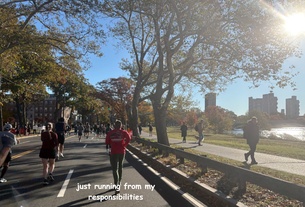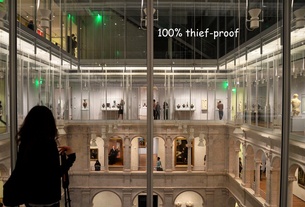Sketchbook
Backward Numbers and Distorted Views
Gates, by nature, are viewed from two directions: the outside as you enter and the inside as you exit. Grillwork can also be viewed from both sides, but one side is the reverse of the other. With abstract and symmetrical shapes, this duality works nicely. However, a number that looks right from one side will look backwards from the other. Therefore, in designing a gate with a number, the artist must favor one viewpoint over another. As I walked around the Yard, I found that many of the gates were oriented outwards, so that from the inside the numbers appeared backwards. In some cases, a flat background allowed the artist to include two sets of numbers, one oriented inward and one outward. While this solves the problem of the backwards numerals, it sacrifices the stark and beautiful contrast of the numbers against the backdrop of the sky. In no cases were the numbers oriented inwards, so that to view them from the outside was to view them backwards.
Cats, Snakes, and Law School
This was, of course, only a gut reaction and did not satisfy my curiosity. Upon closer inspection, I found cat and snake combinations scattered throughout the facade of the building. Driven by the urge to learn more, I took to the Fine Arts Library, where I soon found myself surrounded by stacks of books about cats and snakes. Richardson’s muse was primarily Romanesque architecture, the product of a period when people viewed cats and snakes with a similar degree of wary respect and ambivalence. But cats and snakes—and mice—have been tied together throughout art history. Cat and snake imagery are linked in Egyptian, Buddhist, Kabbalist and North American tradition. Images from ancient Egypt depict a battle between the cat-goddess Bast and the evil snake Apophis. The North American feathered serpent of Teotihuacan has a feline head that is remarkably similar in appearance to the cats of the Austin hall drainpipes.
Dining Halls
As the Harvard University Dining Service workers strike, many of the dining halls have stopped serving food. As a result, the spaces that are the House dining halls have fundamentally changed. While no food is served in the halls, these spaces remain open, and students have continued to use them. Based on my limited observation as I sat and sketched, it seems that Adams dining hall has become primarily a place of study. Without the draw of meals, it is now emptier and quieter, creating an atmosphere similar to that of a library. Yet chatter still fills the space, as some of the informality of a dining hall is retained. Almost overnight, without any alteration to the physical features or architecture, the house dining halls have been transformed into spaces that are entirely new.
Widener
{image id=1316964 align=center size=large caption=false}Widener is, however, more than the overall structure, and more even than the minute details. Every building has a purpose and a relationship with the people that walk its halls. For many structures, that purpose is not immediately evident or observable. With Widener, one begins to see that relationship even before setting foot inside the building. Students spill out of the building, sitting, studying and reading on its steps, in proximity to the great library but not hidden from the bustling Harvard Yard. In this way, the world of books and records that is Widener Library and the living, breathing world of the students who browse its shelves blur together.




